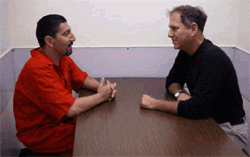|
 "The
Reporter and The Gang Banger: A Tale of How Persistence Can
Pay Off" "The
Reporter and The Gang Banger: A Tale of How Persistence Can
Pay Off"
By Robert Rand
I never should have met Tony Alvarado. He's a former gang
banger who grew up in the hard scrabble projects of Pacoima
just north of downtown Los Angeles. I'm an east coast, Ivy
League graduate who spent two years on the debutante circuit.
But thanks to serendipity and the Pot Prince of Bel Air, Tony
and I ended up in the same courtroom one crisp fall morning
nearly two years ago. Neither of our lives will ever be the
same.
You don't bump into many TV reporters in federal court. That's
because cameras are not allowed. Sketch artists just don't
work as much they used to. Everything changed when California
courts began admitting cameras to broadcast and record events
in a never ending search for Perry Mason moments.
Then there was OJ . . . but that's a different story. I like
federal courts. You can hear yourself think versus the cacophony
that permeates local and state halls of justice. Also, one
can frequently unearth unusual stories that never show up
on media radar screens. I was attending a hearing in the long-running
saga of Todd McCormick, a cancer patient and medical marijuana
advocate LA reporters branded "The Pot Prince of Bel Air."
The Pot Prince was late for court. "He must be stoned again"
snickered one of my colleagues.
The 27-year old activist was busted for growing 4000 plants
inside a Bel Air mansion on Stone Canyon Road. The late LA
Sheriff Sherman Block (who was fighting his own cancer with
chemotherapy) told reporters McCormick "must be very, very
healthy since he claims he was growing the plants for medical
use." Southern California media outlets collectively winked
with stories full of double entendres.
McCormick, who fights constant pain from cancer of the spine,
insisted he was growing the plants for scientific research.
He was developing specific strains of marijuana to treat specific
illnesses. Through source interviews and other reporting,
I discovered there were hard facts that actually backed him
up. [Recent studies at several prestigious universities and
the National Institute of Health concluded pot could be effective
for fighting pain, nausea and glaucoma.]
The feds couldn't come up with a shred of evidence that Todd
McCormick had ever sold a single joint. So they indicted him
for gardening. McCormick believed he was protected under California's
Prop 215 which legalized the medical use of pot. The law was
deliberately written to be vague. It doesn't specify what
medical conditions allow one to smoke without fear of arrest.
It doesn't say how much marijuana a patient can grow.
When I interviewed California attorney general Dan Lundgren
two years after voters bypassed the legislature with a ballot
proposition, even Lundgren, the state's chief law enforcement
officer, awkwardly sputtered before admitting " growing a
couple of plants for personal use sounded reasonable." Actor
Woody Harrelson put up a half million dollars cash to bail
the Pot Prince out of jail. Harrelson, Hustler publisher Larry
Flynt, "Politically Incorrect" host Bill Maher and others
contributed to McCormick's legal defense fund. McCormick's
high priced San Francisco lawyer was there. But the PPBA was
AWOL. Hearing delayed. Todd McCormick is serving a 5-year
sentence at the federal prison on Terminal Island. He was
not allowed to introduce a medical necessity defense so he
accepted a plea agreement. That ruling is being appealed.
Judge George King called another case to fill the void. David
Katz, a former AUSA who crossed over to criminal defense work,
began reciting a lengthy but compelling story about his client,
Antonio Alvarado Torres. I was drawn into Katz's tale. I studied
Alvarado, a compact 28-year old former teenage gang banger
with close cropped hair and a hawk-like nose. Tony Alvarado
looked both scary and scared at the same time. I could envision
people lowering their eyes if they encountered this guy strutting
down a street wearing baggy clothes and a bandanna. Yet, I
was drawn to the story.
I followed Katz into the hallway and expressed my interest
in Tony's case. Tony Alvarado's parents brought him to LA
from a small village near Guadalajara when he was only a few
months old. He grew up in the Pacoima projects where gang
membership was a rite of passage and survival. He had two
minor juvenile arrests. By 1990, Alvarado was maturing. He
gradually cut his ties and moved away from gang life. He began
working with troubled kids at a local rec center.
On July 6, 1990, 19-year old Tony Alvarado got a ride from
a friend, Luis Selvera. He needed to pick up a tuxedo for
a wedding that weekend. The pair was pulled over and given
a ticket for a broken tailight. Ten minutes later, they were
pulled over again by officers from CRASH, the LAPD's anti-gang
unit. The CRASH cops were familiar with the two gang bangers.
In court testimony later, one officer testified he "smelled
PCP" when he approached the car. A search turned up a bag
with sealed vials of PCP under Selvera's seat. 15-year old
Selvera, whose nickname was Peanut, immediately admitted the
drugs were his. He vigorously protested when officers handcuffed
Alvarado. "Why are you taking him away?" asked Peanut. "He
didn't know I had anything under the seat." But both were
arrested and charged with possession with intent to sell PCP.

Tony Alvarado being interviewed by Robert Rand on May
5, 2000 at the Immigration Detention Facility Jail on
Terminal Island, San Pedro, California. |
Tony spent several months in the LA County Jail insisting he
was innocent. He wanted a trial. [Alvarado insists there was
no smell of PCP in the car. He argues the first LAPD stop would
have led to search if there had been an unsual odor in the car.
He believes the CRASH officers simply saw an opportunity to
remove two gang bangers off the street.] By October, a public
defender suggested an alternative. Tony could accept a plea
agreement and be out in a few weeks. He would receive time served
as his sentence. Going to trial could mean a six month wait
behind bars followed by the uncertainty of conviction and state
prison time. Still, Tony wanted to roll the dice. But the lawyer
won out.
Today, Tony insists he was never informed (as a judge is required
to do) that his acceptance of the plea agreement could negatively
impact his immigration status. [A court minute order exists
with a brief summary of the hearing but my search for the court
transcripts ended in failure. The court reporter broke the rules
by taking the transcripts (which are supposed to be archived)
home to her garage. After she suffered a stroke, her family
threw out all her files. This is a critical piece of missing
evidence that can never be recovered.]
After being released, Tony stayed out of trouble and continued
his work with troubled kids. "Without Tony, some of these children
would be lost to gangs and drugs" wrote Congressman Howard Berman
in a 1991 letter of commendation.
Tony married his high school sweetheart, Maricela, and began
a family. Both his wife and baby son are US citizens. But in
1993, Tony's application for immigration amnesty and citizenship
was denied because of his one adult drug conviction. The FBI
offered a deal: Tony could stay in the US if he became an informant
against the young people he was trying to save. He refused and
was deported to Mexico.
He'd never lived south of the border. He didn't even speak Spanish.
After 24-hours in Tijuana, Tony walked back across the border
and returned to his family in Pacoima, the only home he'd ever
known. Two years went by. Tony and Maricela had a second baby.
They saved and bought a small house in San Fernando. They both
became born again Christians. Besides Sunday services, they
attended a Bible study class at Calvary Chapel in Sylmar two
nights a week. Their faith was about to be tested.
One afternoon, Tony was walking down a Pacoima street when he
ran into the same FBI agent who ordered him deported in 1993.
Once again, Tony ended up in a small room filled with federal
agents. "Help us out," the G-men pleaded, "and you can stay"
they promised. "No thanks," replied Tony. He'd been out of the
gang life for over five years. He had no desire to go back in.
Of even greater significance: he wasn't going to put his wife
and now two boys in danger. The FBI agent gave Tony his business
card. "I know you'll be back, so hang onto this, " he said with
a smirk. Once again, Tony was bussed by the INS to Tijuana and
dropped off. This time, he returned to the tiny village his
parents had left. Most of the local men were sheep herders.
For three months, Tony tried to herd sheep. Perhaps Maricela
and the kids would join him and start a new life. But the culture
shock was too great. He missed his family. He missed LA.
So one afternoon, he walked across the border at Tijuana and
returned home. Fast forward two years. August 1999. A routine
traffic stop. A routine question: are there any warrants out
for you? Maybe. Tony admitted there might be an INS warrant.
Within hours, he was back in the same room with many of the
same FBI agents from two years earlier including the man who
gave Tony his card.
Now, it was more serious. Work with us, said one, or else. Tony
wanted to think it over. In his heart, he already knew what
he wouldn't do. This time was different. Tony was charged with
the federal crime of illegal re-entry. For two months, he sat
in the Metropolitan Detention Center in downtown LA.
He held an instant get out of jail card but refused to play
it. An FBI agent invited Maricela out for lunch. The couple
didn't cave. Which led me to the bail hearing that day in October
1999 where my path crossed with Tony Alvarado. Tony's story
was sympathetic. The judge released him on bail from the criminal
jail. Ten days later, his family scraped together the money
to free him. But he never went home.
The INS was waiting at the jail door to grab him. They took
Tony to the immigration detention facility on Terminal Island,
directly across the street from the federal prison where the
Pot Prince of Bel Air would be jailed three months later. (Illegal
aliens can spend months or even years in detention until their
case is resolved. There is no speedy trial clock running as
in the criminal justice system.)
In November 1999, UPN News 13 broadcast the first of what would
eventually become 18 months of continuing coverage of the Alvarado
story. I interviewed Tony's wife and kids (there were now three
sons) as well as his attorney David Katz. It was difficult to
maintain my composure as Maricela Alvarado, with her eyes full
of tears, begged for her husband's freedom.
His boys need him, she pleaded. Tony called in from jail while
we were shooting the interviews. It was our first brief conversation
of what became months of nightly phone calls. After weeks of
dogged persistence, the INS let me interview Tony at the immigration
detention facility just before Christmas 1999. Cameras are rarely
permitted inside the jail. Tony looked much smaller and less
threatening up close. It was an easy interview.
We'd become familiar with each other's lives through nightly
calls that typically ran 15 or 20 minutes. I was happy to be
able to finally shake his hand. Just before Christmas, we went
back to interview Maricela and the kids. They were facing a
bleak holiday. The only presents under the tree were books from
a prisoners' support group. They could go and visit Tony on
weekends but the trip consumed an entire day of travel and frustration.
A few days later, the INS finally agreed to an interview.
I had been speaking almost daily with the PIO. Now, I was going
to meet Leonard Kovensky, the deputy director of deportation.
When I showed up with a camera, everybody looked confused. "Oh,
we can't do this on camera," said the PIO. "We simply said we'd
talk with you for background. We didn't agree to on camera."
Hello? This is TV news! What did they think I meant by setting
up an interview? Four months went by. Numerous phone calls.
INS. US Attorneys' office. Maricela. And, of course, every night
about ten, Tony himself.
I managed to convince management at UPN News that they should
do an update ever couple of weeks. I became adept at coming
up with pitches that made it sound like there was something
new even though there usually wasn't. This had become more than
a story for me. I wanted to help this guy out. Finally, a major
break.
I unearthed the ten year old court file and began tracking down
witnesses. Luis Selvera, a.k.a. Peanut, was in the Wayside Jail
on an unrelated new drug charge. He was about to be shipped
to state prison where no cameras are allowed. On a day when
there were no cameras available at UPN News 13, I lucked out
at the last minute. (Thank you Bob Guerrero.) Selvera told a
compelling story that pointed to Tony's innocence. He took complete
responsibility for the PCP that had been in his car. We ran
the story with these new developments.
Two weeks later, the LA County DA's office announced they would
not oppose overturningTony's 1990 conviction, the foundation
of his deportation problem. The INS, however, wouldn't budge.
Our stories were full of good journalism, but the government
didn't seem to care.
Tony was still in jail, one of 100,000 pending cases in the
INS' LA office. Out of sheer frustration, I approached a friend
at the LA Times and filled her in on Tony's situation.
In late April 2000, Anne-Marie O'Connor wrote a lengthy story
about Tony's case. The Time's front page investigation called
Tony's 1990 plea agreement "a dubious conviction." Three days
after the Times story ran, my phone rang at 7:30 in the morning.
"Mr. Rand, this is Alejandro Mayorkas, the US Attorney," said
the caller. He wanted to discuss Tony's case. My six months
of phone calls to his office had gone unreturned. Five months
of UPN News 13 stories were ignored. But somebody noticed the
front page of the LA Times.
Mayorkas became my new best friend. A few hours later, the INS
called. Suddenly, they wanted to do an on camera interview.
Three weeks later, on May 23, 2000, Tony Alvarado was released
on an INS bond of $10,000. I hugged him as he walked through
the gate. It was an incredibly powerful TV moment as his three
sons sprinted down a street to the father they hadn't been able
to hug for nine months. The story made the front page of the
Times and the Daily Journal, a legal trade paper.
It marked the first time in US history that an illegal alien
had ever been released on bond while his case was still pending.
Two weeks later, The US Attorney's office reduced Tony's illegal
re-entry charge to a Class B misdemeanor.
On July 4, 2000 UPN News shot a poignant interview with Tony
Alvarado and his family as Tony celebrated his first legal 4th
of July in the USA. Tony was expected to receive time served
at his sentencing on April 30, 2001. It never happened. The
judge postponed sentencing when he realized three INS agents
with chains and handcuffs were in the back of the courtroom
waiting to arrest Tony.
I swung into action again with phone calls and letters. Leonard
Kovenksy, now deputy district director (the number two job in
the INS' LA office) graciously spent a half an hour discussing
the case with me over the phone.
On May 21, 2001, the INS issued an order allowing Tony Alvarado
to remain free on bond pending an INS review of his case. The
INS review of Tony's status could take several years. Maricela
Alvarado has applied to obtain citizenship for her husband.
In the end, it was persistence (and a little luck) that freed
Tony Alvarado.
UPN news 13 has entered the story for numerous journalism honors.
I've already received the best award: that was the day Tony
Alvarado walked out of the immigration jail a free man.
About the Author
Robert Rand is a freelance journalist who works in both TV and
print. On June 23, 2001, Rand received a Los Angeles Emmy award
for his reporting on the Alvarado case. He is currently finishing
a hardcover book on the Menendez murder case which he covered
for the Miami Herald and Playboy.
|

















